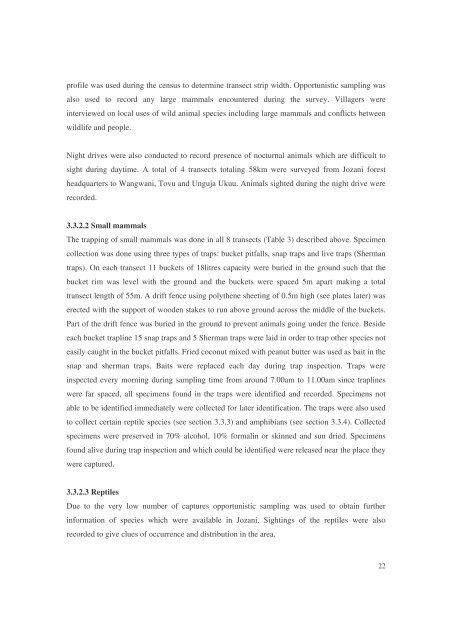Jozani biodiversity inventory report 2002 - Coastal Forests of Kenya ...
Jozani biodiversity inventory report 2002 - Coastal Forests of Kenya ...
Jozani biodiversity inventory report 2002 - Coastal Forests of Kenya ...
Create successful ePaper yourself
Turn your PDF publications into a flip-book with our unique Google optimized e-Paper software.
pr<strong>of</strong>ile was used during the census to determine transect strip width. Opportunistic sampling was<br />
also used to record any large mammals encountered during the survey. Villagers were<br />
interviewed on local uses <strong>of</strong> wild animal species including large mammals and conflicts between<br />
wildlife and people.<br />
Night drives were also conducted to record presence <strong>of</strong> nocturnal animals which are difficult to<br />
sight during daytime. A total <strong>of</strong> 4 transects totaling 58km were surveyed from <strong>Jozani</strong> forest<br />
headquarters to Wangwani, Tovu and Unguja Ukuu. Animals sighted during the night drive were<br />
recorded.<br />
3.3.2.2 Small mammals<br />
The trapping <strong>of</strong> small mammals was done in all 8 transects (Table 3) described above. Specimen<br />
collection was done using three types <strong>of</strong> traps: bucket pitfalls, snap traps and live traps (Sherman<br />
traps). On each transect 11 buckets <strong>of</strong> 18litres capacity were buried in the ground such that the<br />
bucket rim was level with the ground and the buckets were spaced 5m apart making a total<br />
transect length <strong>of</strong> 55m. A drift fence using polythene sheeting <strong>of</strong> 0.5m high (see plates later) was<br />
erected with the support <strong>of</strong> wooden stakes to run above ground across the middle <strong>of</strong> the buckets.<br />
Part <strong>of</strong> the drift fence was buried in the ground to prevent animals going under the fence. Beside<br />
each bucket trapline 15 snap traps and 5 Sherman traps were laid in order to trap other species not<br />
easily caught in the bucket pitfalls. Fried coconut mixed with peanut butter was used as bait in the<br />
snap and sherman traps. Baits were replaced each day during trap inspection. Traps were<br />
inspected every morning during sampling time from around 7.00am to 11.00am since traplines<br />
were far spaced, all specimens found in the traps were identified and recorded. Specimens not<br />
able to be identified immediately were collected for later identification. The traps were also used<br />
to collect certain reptile species (see section 3.3.3) and amphibians (see section 3.3.4). Collected<br />
specimens were preserved in 70% alcohol, 10% formalin or skinned and sun dried. Specimens<br />
found alive during trap inspection and which could be identified were released near the place they<br />
were captured.<br />
3.3.2.3 Reptiles<br />
Due to the very low number <strong>of</strong> captures opportunistic sampling was used to obtain further<br />
information <strong>of</strong> species which were available in <strong>Jozani</strong>. Sightings <strong>of</strong> the reptiles were also<br />
recorded to give clues <strong>of</strong> occurrence and distribution in the area.<br />
22
















